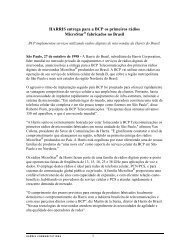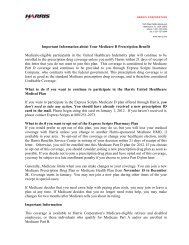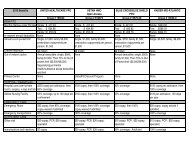METHOD OF ALLOCATING MULTIPLE ASYNCHRONOUS DATA ...
METHOD OF ALLOCATING MULTIPLE ASYNCHRONOUS DATA ...
METHOD OF ALLOCATING MULTIPLE ASYNCHRONOUS DATA ...
You also want an ePaper? Increase the reach of your titles
YUMPU automatically turns print PDFs into web optimized ePapers that Google loves.
Through the repeated simulation of an IW communications<br />
system containing a given percentage of large services,<br />
composed of random timeslot sizes, it was possible to analyze<br />
the impact of large service requests on the average<br />
level of channel fragmentation in an IW communications<br />
system. As shown in Figure 3, the amount of channel<br />
fragmentation increases substantially as the percentage of<br />
large timeslots within the IW communications system increases.<br />
One particular concern is that the level of channel<br />
fragmentation begins to increase when the percentage of<br />
large timeslots in an IW communications system reaches<br />
as little as twenty percent.<br />
Channel Fragmentation (%)<br />
35.00<br />
30.00<br />
25.00<br />
20.00<br />
15.00<br />
10.00<br />
5.00<br />
0.00<br />
0 10 20 30 40 50 60 70 80 90 100<br />
Percentage of Large Services<br />
Figure 3: Initial Service Allocation Channel Utilization<br />
4. RESIDUAL CHANNEL SPACE<br />
As previously mentioned, and shown in figure 2, due to the<br />
enhanced flexibility of the IW protocol there will inevitably<br />
be a non-zero amount of channel fragmentation within<br />
an IW communications system. Additionally, while the<br />
residual channel spaces in an IW communications system<br />
may contain enough contiguous time chips to support a<br />
low data rate and high over-the-rate service, most users<br />
want to be able to send their information as quickly and<br />
reliably as possible and thus will need services that consume<br />
larger timeslots. Furthermore, even if a service request<br />
was received by the Network Management System<br />
that would result in a timeslot small enough to be allocated<br />
in this space, the fixed I/O rate synchronous services that<br />
were carried over to the IW protocol from the legacy<br />
DAMA TDMA protocol will typically not consume the<br />
entire residual channel space within a given channel. In<br />
this situation, any leftover residual channel space will frequently<br />
be wasted as the remaining channel space is often<br />
insufficient to accommodate the minimum timeslot necessary<br />
to allocate a TDMA service. Therefore, if there was a<br />
way for the Network Management System to merely allocate<br />
a certain number of contiguous time chips to a service,<br />
and allow the terminal to utilize those time chips to<br />
Paper ID# 900150.PDF<br />
3 of 7<br />
the best of its abilities, the residual channel space could be<br />
optimally exploited and would result in an improvement to<br />
the channel utilization of an IW communications system<br />
while minimizing the impact on user communications performance.<br />
5. <strong>ASYNCHRONOUS</strong> <strong>DATA</strong> TRANSFER (ADT)<br />
SERVICES<br />
Fortunately there is a new feature in the IW protocol, in<br />
addition to the enhancement in service allocation flexibility,<br />
which is capable of being utilized to facilitate the maximum<br />
usage of residual channel space within an IW communications<br />
system while minimizing the impact to user<br />
communications performance.<br />
Asynchronous data transfer services (ADT) are a new type<br />
of service that were added to the IW protocol to provide<br />
enhanced data transfer capabilities to user terminals and to<br />
provide the Network Management System with increased<br />
service allocation flexibility. ADT services are capable of<br />
providing a communications link that can support variable<br />
rate data transfers by permitting the usage of timeslots of<br />
nearly any arbitrary size. Additionally, once a terminal<br />
has been assigned an ADT service, it is able to more optimally<br />
utilize the channel space allotted by varying, on a<br />
frame-by-frame basis, which modem is employed during<br />
transmission. Furthermore, because it can beneficially<br />
assumed that terminals assigned to ADT services are also<br />
utilizing an asynchronous data protocol, such as MIL-<br />
STD-188-184[5], the amount of channel space provided by<br />
the Network Management System in response to a service<br />
allocation request does not need to exactly line up with the<br />
quantity requested by the user. For example, if the allocated<br />
timeslot for a requested ADT service is smaller or<br />
larger than that requested, the terminal would still be capable<br />
of transferring data, albeit at a slower or faster rate.<br />
By utilizing the ability to allocate an ADT service of arbitrary<br />
size the Network Management System can provide a<br />
timeslot that more closely meets the needs of a service request<br />
by a terminal that can support ADT services. Consequently,<br />
the channel space that would have otherwise<br />
been utilized for the allocation of a fixed rate data rate service<br />
can be utilized to accommodate future service allocation<br />
requests. Unfortunately, there are times when the<br />
amount of channel space remaining in an IW communication<br />
system is sufficient to meet the needs of a service allocation<br />
request, but because this space is not contiguous it<br />
will seldom be utilized to fulfill the service request. As a<br />
result, the Network Management System will either allocate<br />
a timeslot that was smaller than what was requested<br />
by the terminal or outright deny the service allocation request.<br />
Therefore, additional steps must be taken to avoid<br />
not entirely fulfilling a service request when there is channel<br />
space available but that space is not contiguous.
















